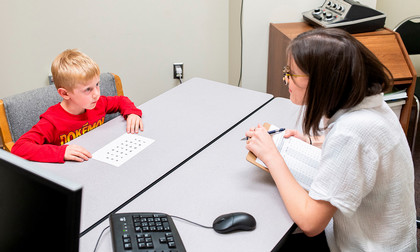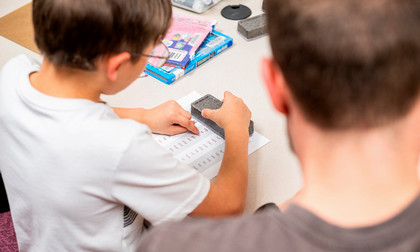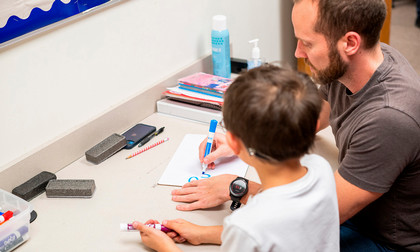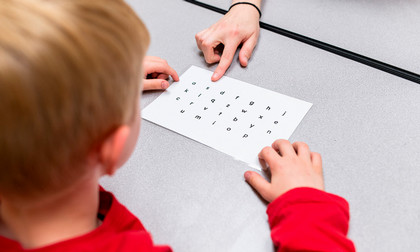It’s part of a new statewide plan called Blueprint for Literacy being rolled out in Kansas, where in December 2024, the Board of Regents formally approved the creation of Centers for Excellence in Reading at Kansas State, Wichita State, Emporia State, Fort Hays State, Washburn University, and Pittsburg State University.

Data shows that 30 percent of all Kansas students are reading below their grade level.
“But it wasn’t adding up to why our students weren’t performing better in state assessments in English and language arts,” said Dennis Burke, a retired superintendent who works for Pitt State on the Blueprint. “Districts were putting a lot of resources in qualified staff, and it was not moving the needle. Too many students were reading below basic levels.”
“It comes back to ‘How do we better prepare our future teachers the most effective way to teach reading?’,” Burke said.
The answer, Burke said, lies in what Pitt State Professor of Psychology David Hurford has been doing for children at the Pitt State Center for Reading since 1996. There, Hurford and his team have been providing evaluation, science-based intervention, and advocacy services to individuals with dyslexia and other reading difficulties on a case-by-case basis.
He found that neurologically, struggling readers have trouble decoding letters. And, he realized, all students – not just those with dyslexia -- could benefit from approaching reading as if it were decoding.

In recent years, as other states have grappled with reading struggles, Hurford, now considered an expert, has been appointed to task forces and consulted by visiting governors.
“We need to start listening to science. We need to rework how we train pre-service teachers based on what we know now. And we need to help teachers in the field get up to speed on that science,” Hurford said. “By doing this, we can solve a multitude of problems.”
Hurford found an ally in now retired Kansas Sen. Molly Baumgardner, who became a driver of the 2018 task force on dyslexia.
“She is a champion for reading. She went to her colleagues and said, “We need to do something about it,’ and they listened, strategized, and made changes,” Hurford said.
Baumgardner recently signed on as Pitt State’s associate vice president for public affairs and community engagement and is playing a key role in the development of the Blueprint.
Pitt State President Dan Shipp also became an advocate. Diagnosed with dyslexia, he struggled as a child. Regent Cynthia Lane, a Pitt State graduate and former superintendent, also was a driving force.
Assistant Professor Jennifer Richardson from the Pitt State College of Education has been actively engaged in developing two new Science of Reading courses required of all elementary education majors along with the support of Provost Susan Bon and Interim Chair Jason Clemensen have been instrumental in supporting these changes. Retired provost Howard Smith, and Ed McKechnie, special assistant for governmental affairs, have been strong advocates and currently serve on the state-wide Literacy Advisory Committee.
Last April, the Kansas Department of Education published new reading standards, and included in that was the edict that teachers are to no longer use a non-science reading approach. By 2028, all K-5 teachers being relicensed must get a literacy seal.
All told, more than 40 districts in Southeast Kansas are to be served by PSU’s Center for Literacy. The catchment area includes 14 counties: Miami, Anderson, Linn, Woodson, Allen, Bourbon, Elk, Wilson, Neosho, Crawford, Cherokee, Labette, Montgomery, and Chautauqua.
PSU’s Center will provide literacy coaches to assist the classroom teacher in whole-classroom reading instruction as well as in modeling diagnostic and prescriptive interventions for individual students

The College of Education and the Center for Reading will collaborate to develop a lab classroom where pre-service teachers and current teachers will be trained. It will be located, along with the Center, at the soon-to-be renovated Besse Hotel in downtown Pittsburg.
Space also will be identified in Hughes Hall for a lab classroom.
On Feb. 19 and Feb. 28, superintendents, school district leaders, and educators from across the region will gather to hear about the Blueprint and PSU’s Center in a meeting at Block22 next door to the Besse Hotel and home to the university’s Research & Economic Development division.
This fall, two new graduate-level reading courses will be implemented at Pitt State.

“People are ready. There is an excitement of being able to do something that is so fundamentally critical for kids, knowing that we can make this happen, that this isn’t pie in the sky – it's attainable,” Burke said. “All kids can become successful readers. And with that, they have access to more opportunities. We can solve so many future problems by ensuring that all children can read well.”
The Blueprint received $10 million in state funding to be used at seven Centers for Excellence across Kansas to help teachers in the field learn Structured Literacy strategies, and to support families. It is hoped that the Legislature will provide annual funding so that the Centers of Excellence in Literacy can do the work that is so vital to improving reading skills.
The seven centers will be places where teachers can go to take classes needed to get their credentials in the science of reading, either with in-person or remote (online) classes -- although some teachers may already have the skills that will allow them to take a single test to show they have the needed competencies.
“The way so many individuals, offices, and programs at the university level and at the state level have united in a common goal is unique, and a great testament to the way collaboration will be the key to creating more competent readers,” Baumgardner said. “What we’re doing is something no other university is doing, and ultimately it will lead to a more equipped public, and no doubt could help reduce poverty in our state.”
The university's Research + Economic Development Division connects the university, community, and government to foster innovation, economic growth, and collaboration. With a focus on economic development, research support, and community engagement, the division drives discovery, strengthens partnerships, and enhances regional prosperity.
It also serves as the university’s liaison to government officials and oversees Block22, a living-learning community in Downtown Pittsburg created through a unique partnership with the City of Pittsburg and the Vecino Group.